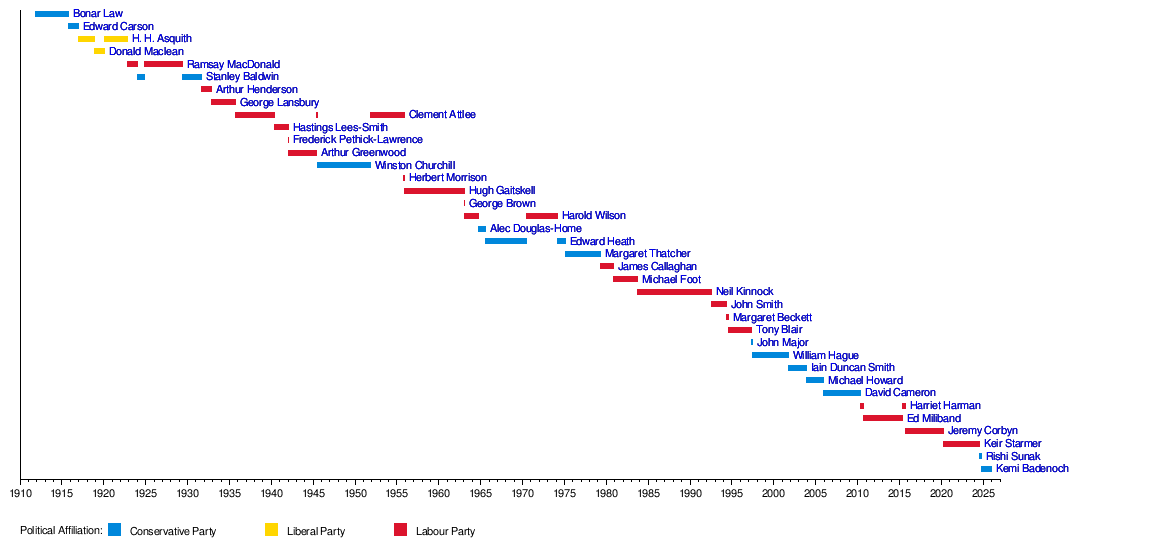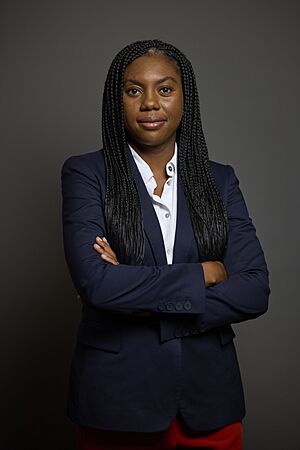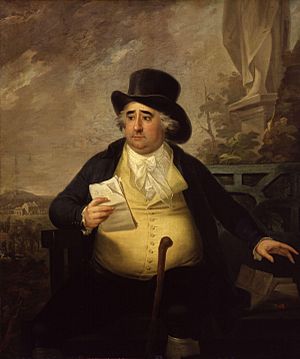Leader of the Opposition (United Kingdom) facts for kids
Quick facts for kids Leader of His Majesty's Most Loyal Opposition |
|
|---|---|
| Official Opposition Parliament of the United Kingdom Leader of the Opposition's Office |
|
| Style | Leader of the Opposition (informal) The Right Honourable (formal) |
| Member of | |
| Appointer | Largest political party in the House of Commons that is not in government, serves at the pleasure of His Majesty. |
| Term length | While leader of the largest political party in the House of Commons that is not in government |
| Inaugural holder | The Lord Grenville |
| Formation | March 1807 1 July 1937 (Statutory) |
| Deputy | Deputy Leader of the Opposition |
| Salary | £144,649 (including £91,346 MP salary) |
| Website | His Majesty's Official Opposition: The Shadow Cabinet: https://members.parliament.uk/Opposition/Cabinet |
The Leader of His Majesty's Most Loyal Opposition, usually called the Leader of the Opposition, is the person who leads the main opposition party in the United Kingdom. This important job is seen as being like a "shadow" Prime Minister.
The Leader of the Opposition is usually the head of the biggest political party in the House of Commons that is not part of the government. If one party wins the election clearly, then the leader of the second-largest party becomes the Leader of the Opposition. This role, which started as a tradition, was later made official by law.
The Leader of the Opposition is often thought of as the next possible Prime Minister. They become a member of the Privy Council, a group of important advisors to the King. They also lead a team called the Official Opposition Shadow Cabinet. This team checks what the government's real Cabinet is doing and suggests different ideas and plans.
In the past, before 1911, the leaders of the opposition in the House of Commons and the House of Lords were sometimes seen as equally important. But since the Parliament Act 1911, it has been clear that the leader in the House of Commons is the most important.
The Leader of the Opposition gets an extra salary on top of their pay as a Member of Parliament (MP). For example, in 2019, this extra pay was about £65,181.
The current Leader of the Opposition is Kemi Badenoch. She became the Leader of the Conservative Party after the 2024 Conservative Party leadership election. She took on this role on November 2, 2024.
Contents
How the Leader of the Opposition Role Developed
The idea of a "Leader of the Opposition" started to become clear in the early 1800s. One of the first people to act in this role was Charles James Fox. He led the Whig party for many years.
Early Leaders (1807–1937)
For there to be a clear Leader of the Opposition, there needed to be strong, organized political parties. This started to happen around 1807. The Whig party, for example, decided to have leaders in both the House of Commons and the House of Lords.
After the 1807 election, Lord Grenville led the Whigs in the House of Lords. His colleague, Viscount Howick, was the leader in the House of Commons. When Howick moved to the House of Lords, the Whigs needed a new leader in the Commons.
They chose George Ponsonby to lead the opposition in the House of Commons. He was the first person to hold this specific role. Even though he was not a very strong leader, he stayed in the position until he died in 1817.
After Ponsonby, there was a period where the Whigs struggled to find a strong leader in the Commons. Sometimes the role was empty, or someone acted as leader without full support.
The term "His Majesty's Opposition" was first used in 1827 by John Cam Hobhouse. This showed that the opposition was seen as a loyal part of the political system, even though they disagreed with the government.
By 1830, the main political parties, the Tories (who later became the Conservatives) and the Whigs (who later became the Liberals), took turns being in power and in opposition. This made it easier to identify who the Leader of the Opposition was in each House.
A tradition grew that if the leader of the opposition had been the last Prime Minister, they would be seen as the overall party leader. If not, the leaders in both Houses were considered equal.
In 1846, the Conservative Party split. Lord Stanley led the larger group in the House of Lords. In the House of Commons, it was harder to find a clear leader until Benjamin Disraeli eventually took charge in 1851.
The Parliament Act 1911 changed things a lot. It made the House of Commons much more powerful than the House of Lords. From this point on, the Leader of the Opposition in the House of Commons became the most important opposition leader.
During World War I, the main parties formed a coalition government. This meant there was no real opposition, so the role of Leader of the Opposition was empty for a while. Later, when parties left the coalition, new leaders emerged.
In 1918, the Labour Party became the largest opposition party. However, they didn't have a single leader for a few years. During this time, Sir Donald Maclean and then H. H. Asquith (who returned to Parliament) acted as the opposition leaders for the Liberal Party.
Since 1922, the main government and opposition parties have usually been the Labour Party and the Conservative Party.
Official Leaders (from 1937)
The job of Leader of the Opposition was officially recognized by law in the Ministers of the Crown Act 1937. This law made sure the leader received a salary and defined who the leader should be.
Here are some key points from the law:
- The Leader of the Opposition gets an annual salary.
- The law says the "Leader of the Opposition" is the MP who leads the party with the most members in the House of Commons that is not in government.
- If there's any confusion about who the leader is, the Speaker of the House of Commons makes the final decision.
Later laws also recognized the Leader of the Opposition in the House of Lords. These laws confirm that to be a leader, a person must be a member of the House they lead.
Since 1937, the Leader of the Opposition has received a salary similar to a government minister. They also get a car with a driver for official duties.
During World War II, the main parties formed another coalition government. This meant the role of Leader of the Opposition was put on hold because there was no "alternative party capable of forming a Government." During this time, different Labour MPs acted as spokespeople for the party from the opposition benches.
List of Leaders of the Opposition (1911–present)
- Labour (21)
- Conservative (13)
- Independent Liberal (3)
| Portrait | Leader of the Opposition | Term of office | Elections | Party | Shadow cabinet | |||
|---|---|---|---|---|---|---|---|---|
| Start | End | Duration | ||||||
 |
Bonar Law | 13 November 1911 | 25 May 1915 | 3 years, 194 days | — | Conservative
(Scot.U.)
|
||
 |
Sir Edward Carson | 19 October 1915 | 6 December 1916 | 1 year, 49 days | — | Conservative
(Irish U.)
|
||
 |
H. H. Asquith | 6 December 1916 | 14 December 1918 | 2 years, 9 days | 1918 | Independent Liberal | ||
 |
Sir Donald Maclean | 14 December 1918 | 12 February 1920 | 1 year, 61 days | — | |||
 |
H. H. Asquith | 12 February 1920 | 21 November 1922 | 2 years, 283 days | 1922 | |||
 |
Ramsay MacDonald | 21 November 1922 | 22 January 1924 | 1 year, 63 days | 1923 | Labour | ||
 |
Stanley Baldwin | 22 January 1924 | 4 November 1924 | 288 days | 1924 | Conservative | ||
 |
Ramsay MacDonald | 4 November 1924 | 5 June 1929 | 4 years, 214 days | 1929 | Labour | ||
 |
Stanley Baldwin | 5 June 1929 | 24 August 1931 | 2 years, 81 days | — | Conservative | ||
 |
Arthur Henderson | 1 September 1931 | 25 October 1932 | 1 year, 55 days | 1931 | Labour | ||
 |
George Lansbury | 25 October 1932 | 8 October 1935 | 3 years, 349 days | — | |||
 |
Clement Attlee | 25 October 1935 | 11 May 1940 | 4 years, 200 days | 1935 | |||
| Hastings Lees-Smith | 22 May 1940 | 18 December 1941 | 1 year, 211 days | — | ||||
 |
Frederick Pethick-Lawrence | 21 January 1942 | February 1942 | 12 days | — | |||
 |
Arthur Greenwood | February 1942 | 23 May 1945 | 3 years, 112 days | — | |||
 |
Clement Attlee | 23 May 1945 | 26 July 1945 | 65 days | 1945 | |||
 |
Winston Churchill | 26 July 1945 | 26 October 1951 | 6 years, 93 days | 1950 | Conservative | ||
| 1951 | ||||||||
 |
Clement Attlee | 26 October 1951 | 25 November 1955 | 4 years, 31 days | 1955 | Labour | ||
 |
Herbert Morrison | 25 November 1955 | 14 December 1955 | 20 days | — | |||
 |
Hugh Gaitskell | 14 December 1955 | 18 January 1963 | 7 years, 36 days | 1959 | |||
 |
George Brown | 18 January 1963 | 14 February 1963 | 28 days | — | |||
 |
Harold Wilson | 14 February 1963 | 16 October 1964 | 1 year, 246 days | 1964 | Wilson I | ||
 |
Sir Alec Douglas-Home | 16 October 1964 | 28 July 1965 | 286 days | — | Conservative
(Scot.U.)
|
Douglas-Home | |
 |
Edward Heath | 28 July 1965 | 19 June 1970 | 4 years, 327 days | 1966 | Conservative | Heath I | |
| 1970 | ||||||||
 |
Harold Wilson | 19 June 1970 | 4 March 1974 | 3 years, 259 days | Feb 1974 | Labour | Wilson II | |
 |
Edward Heath | 4 March 1974 | 11 February 1975 | 345 days | Oct 1974 | Conservative | Heath II | |
 |
Margaret Thatcher | 11 February 1975 | 4 May 1979 | 4 years, 83 days | 1979 | Thatcher | ||
 |
James Callaghan | 4 May 1979 | 10 November 1980 | 1 year, 191 days | — | Labour | Callaghan | |
 |
Michael Foot | 10 November 1980 | 2 October 1983 | 2 years, 327 days | 1983 | Foot | ||
 |
Neil Kinnock | 2 October 1983 | 18 July 1992 | 8 years, 291 days | 1987 | Kinnock | ||
| 1992 | ||||||||
 |
John Smith | 18 July 1992 | 12 May 1994 | 1 year, 299 days | — | Smith | ||
 |
Margaret Beckett | 12 May 1994 | 21 July 1994 | 71 days | — | Beckett | ||
 |
Tony Blair | 21 July 1994 | 2 May 1997 | 2 years, 286 days | 1997 | Blair | ||
 |
John Major | 2 May 1997 | 19 June 1997 | 49 days | — | Conservative | Major | |
 |
William Hague | 19 June 1997 | 13 September 2001 | 4 years, 87 days | 2001 | Hague | ||
 |
Iain Duncan Smith | 13 September 2001 | 6 November 2003 | 2 years, 55 days | — | Duncan Smith | ||
 |
Michael Howard | 6 November 2003 | 6 December 2005 | 2 years, 31 days | 2005 | Howard | ||
 |
David Cameron | 6 December 2005 | 11 May 2010 | 4 years, 157 days | 2010 | Cameron | ||
 |
Harriet Harman | 11 May 2010 | 25 September 2010 | 138 days | — | Labour | Harman I | |
 |
Ed Miliband | 25 September 2010 | 8 May 2015 | 4 years, 226 days | 2015 | Miliband | ||
 |
Harriet Harman | 8 May 2015 | 12 September 2015 | 128 days | — | Harman II | ||
 |
Jeremy Corbyn | 12 September 2015 | 4 April 2020 | 4 years, 206 days | 2017 | Corbyn | ||
| 2019 | ||||||||
 |
Keir Starmer | 4 April 2020 | 5 July 2024 | 4 years, 93 days | 2024 | Starmer | ||
 |
Rishi Sunak | 5 July 2024 | 2 November 2024 | 1 year, 161 days | — | Conservative | Sunak | |
 |
Kemi Badenoch | 2 November 2024 | Incumbent | 1 year, 41 days | — | Conservative | Badenoch | |
Timeline of Leaders (1911–Present)

See also
 In Spanish: Anexo:Líder de la oposición (Reino Unido) para niños
In Spanish: Anexo:Líder de la oposición (Reino Unido) para niños



